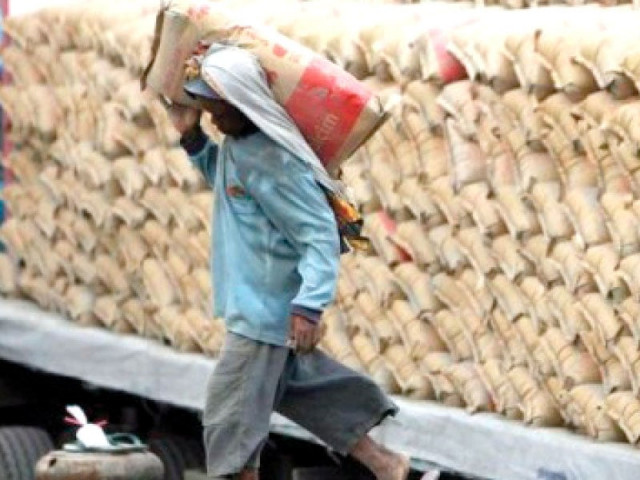Manufacturers asked to search for new markets to stay competitive
Exports have been on a continuous decline for the last 15 months.

Cement exports have been on the wane for the last 15 months and the industry now mainly banks on domestic sales for notching up a respectable growth in the current fiscal year 2013-14. PHOTO: FILE
Cement exports have been on the wane for the last 15 months and the industry now mainly banks on domestic sales for notching up a respectable growth in the current fiscal year 2013-14.
In the first three months (July to September), exports remained weak, shrinking by 1.4% year on year (YoY).
However, according to export data for September, exports jumped a significant 20% and reached 810,000 tons. Overseas sales rose during the month as Pakistan regained a foothold in Afghanistan’s market – one of the biggest export markets – to which shipments grew 41%.
This rise in exports to Afghanistan, where Iranian cement has given a tough time to Pakistani manufacturers has rekindled the hopes of cement companies in the northern region of Pakistan to recapture the lucrative market.
On the other hand, companies working in the south are comfortably on track for sustainable growth in exports with the help of the sea route. Cement exports via sea in September recorded a steady growth of 6% month on month (MoM).

At the beginning of the current financial year,
exports to Afghanistan and India dropped significantly, primarily because of slow economic growth in these two countries. In the first two months (July and August), exports to Afghanistan shrank 11.8% YoY.
Thatta Cement Chief Executive Officer, Muhammad Fazlullah Sharif, told The Express Tribune that the Indian economy had been slowing down continuously, leading to a reduction in cement demand. Moreover, political tensions between the two sides are also hampering exports.
Industry officials point out that Pakistani companies, especially the smaller ones, are finding it hard to compete in the international arena as efficiency levels stay low and profit margins shrink.
However, they continue to target and penetrate African markets – a good sign for exports. Analysts hope that the industry will capture the non-traditional east and central African markets to make up for lower sales in Afghanistan this year.
“With demand in Afghanistan picking up slowly, the negative trend in cement exports is expected to reverse in the near future. But export sales are expected to remain flat year-on-year in the remaining three quarters of 2013-14,” a recent report of research house JS Global said.
In 2012-13, cement exports dropped 2.3% to 8 million tons: around 25% of total production.
Domestic demand remained strong during the year and sales settled at 25.1 million tons, up 4.6% year-on-year, despite the fact that this was an election year with a lot of political uncertainty in the country.
Manufacturers produce around 33 million tons of cement in a year, though their installed capacity is 45 million tons.
Offsetting impact of rupee’s fall
The presence of international revenues on the books of cement companies provides them a partial hedge against rupee depreciation. But since bigger companies export higher volumes, they are able to better cash in on the currency slide compared to mid-tier or smaller companies.
Lucky Cement, the biggest exporter with exports accounting for 38% of total sales, is a major beneficiary with an estimated 1.6% increase in annualised earnings per share (EPS) for a 5% depreciation of the rupee, analysts say.
DG Khan Cement, which exports 27% of its sales, has a 0.1% positive impact on the EPS with 5% rupee depreciation.
Along with Lucky and DG Khan, Cherat Cement, Fecto Cement Attock Cement and Maple Leaf Cement are going to benefit if the rupee drops further against the dollar.
However, the rupee weakness is going to adversely affect smaller companies as they mostly depend on domestic sales. Moreover, because of less efficiency and increase in the cost of imported coal, their profits can be hurt in the near future.
Export contribution to total sales
1) Lucky Cement (LUCK) 38%
2) Cherat Cement (CHCC) 36%
3) Fecto Cement (FECTC) 35%
4) DG Khan Cement (DGKC) 27%
5) Attock Cement (ACPL) 26%
6) Maple Leaf Cement (MLCF) 24%
7) Fauji Cement (FCCL) 20%
8) Pioneer Cement (PIOC) 17%
9) Kohat Cement (KOHC) 15%
Published in The Express Tribune, October 28th, 2013.
Like Business on Facebook, follow @TribuneBiz on Twitter to stay informed and join in the conversation.


















COMMENTS
Comments are moderated and generally will be posted if they are on-topic and not abusive.
For more information, please see our Comments FAQ